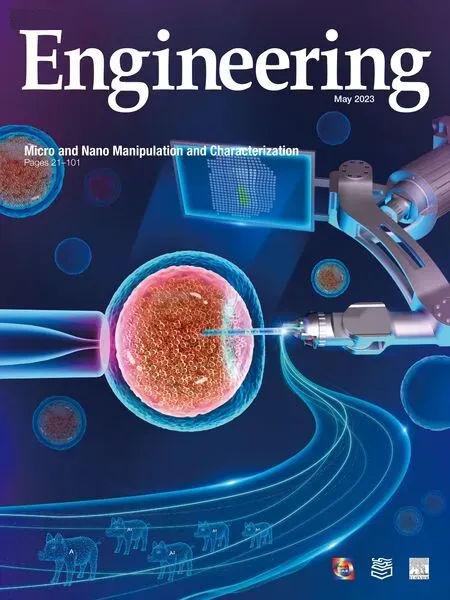Editorial for the Special Issue on Micro and Nano Manipulation and Characterization
Yu Sun, Sergej Ftikow, Xinyu Liu
a Department of Mechanical and Industrial Engineering, University of Toronto, Toronto, ON M5S 3G8, Canada
b Institute for Microrobotics and Control Engineering, University of Oldenburg, Oldenburg D-26129, Germany

Technologies for manipulating micro- and nanometer-sized objects (e.g., biological cells, small organisms, biomolecules, and nanomaterials) and characterizing their physical and chemical properties play important roles in a variety of disciplines such as biology,medicine,microsystems engineering,and nanotechnology.Inventing micro and nano manipulation and characterization techniques requires the seamless integration of multidisciplinary expertise in microphysics, micro/nano device design and fabrication, small-scale robotics, and micro/nano instrumentation.
Significant advances have been achieved in this area in the past few decades.This special issue of Engineering aims to summarize recent achievements and future trends in micro/nano manipulation and characterization and to promote the further development of this field.The issue contains seven articles—two opinion articles,two review articles,and three research articles—authored by influential experts from China, the United States, Germany, Japan, and Australia.These articles illustrate several major topics that have been extensively investigated in this field.
Two strategies for micro and nano manipulation have been reported in the literature: contact-based manipulation and fieldcontrolled manipulation.Contact-based manipulation methods typically employ an end effector(e.g.,a microneedle or nanoprobe)that comes in contact with the target object for manipulation,while field-controlled manipulation methods rely on an external field(e.g.,a magnetic,electrical,or acoustic field)that exerts force on and thus manipulates an object.Regarding contact-based manipulation, Sun et al.present a research article on a robotic micromanipulation system capable of the somatic cell nuclear transfer (SCNT) of animal oocytes with an improved success rate for cloning.In their work, the injection-inducted intracellular strain of an oocyte is reduced via a vision-based strain evaluation method, enhancing the blastocyst rate and cloning success rate.This micromanipulation system could eventually overcome the major barrier presented by the currently low success rate in animal cloning and thereby popularize the cloning technique in animal breeding.Regarding field-controlled manipulation, Wang et al.report a review article on selective and independent control approaches for microrobots by means of a global magnetic field.These control approaches are important for achieving effective cooperation among and diverse manipulation functionalities of multiple microrobots.In an opinion article,Ma and Fischer review acoustic field-controlled manipulation technology, highlight its applications in microfluidic pumping/mixing and bio-sample manipulation, and envision several exciting new possibilities for this powerful technology.
On the frontier of microscale bio-sample characterization, an opinion article and a research article in this special issue focus on microfluidic technologies for disease diagnostics/therapeutics and single-cell analysis, respectively.In the opinion article, Xie et al.outline the role of microfluidic technologies in addressing the global health challenges raised by pulmonary diseases, such as the recent coronavirus disease 2019 ( COVID-19 ) pandemic.Microfluidic technologies have been applied to both basic research on and clinical practices addressing pulmonary diseases, such as in vitro disease model construction,biomarker selection and detection, and localized drug delivery.In the research article, Du et al.discuss the development of a microfluidic device with force-sensing and fluid-exchange capabilities for the dynamic deformation measurement of single bacteria cells under different osmotic conditions.In their work, the device is used to study the function of the mechanosensitive channels of bacteria under osmotic stresses.
In addition,a review article and a research article in this special issue introduce experimental approaches for nanoscale characterization.Mead et al.present a review article on experimental approaches for examining the adhesion behaviors of one-dimensional (1D) nanomaterials.These methods involve certain types of micro/nano manipulation and characterization techniques under optical, electron, or atomic force microscopy (AFM), and the obtained experimental data must be interpreted based on a full understanding of the interfacial mechanics.Zhang et al.report a novel three-dimensional (3D) AFM with a magnetically driven orthogonal cantilever probe configuration.This technique permits the high-resolution AFM imaging of deep grooves with vertical walls and even undercut features, and can be readily integrated into a commercial AFM system.
We hope that this collection of high-quality publications will inspire our readers and spark wide research interests in the field of micro and nano manipulation and characterization.We sincerely thank all the authors for their outstanding contributions to this special issue.Looking forward, many challenges in this field remain to be addressed through innovative solutions, and such solutions can only be achieved through interdisciplinary collaboration among the engineers and scientists in our community.
- Engineering的其它文章
- Development of a High-Capacity Portable Biomass-Combustion-Powered Thermoelectric Generator
- Resolving the Adhesive Behavior of 1D Materials: A Review of Experimental Approaches
- Selective and Independent Control of Microrobots in a Magnetic Field:A Review
- Single-Molecule Methods for Characterizing Different DNA Higher-Order Structures
- Long-Term Cultivation and Meta-Omics Reveal Methylotrophic Methanogenesis in Hydrocarbon-Impacted Habitats
- Acoustic Micro-Manipulation and Its Biomedical Applications

